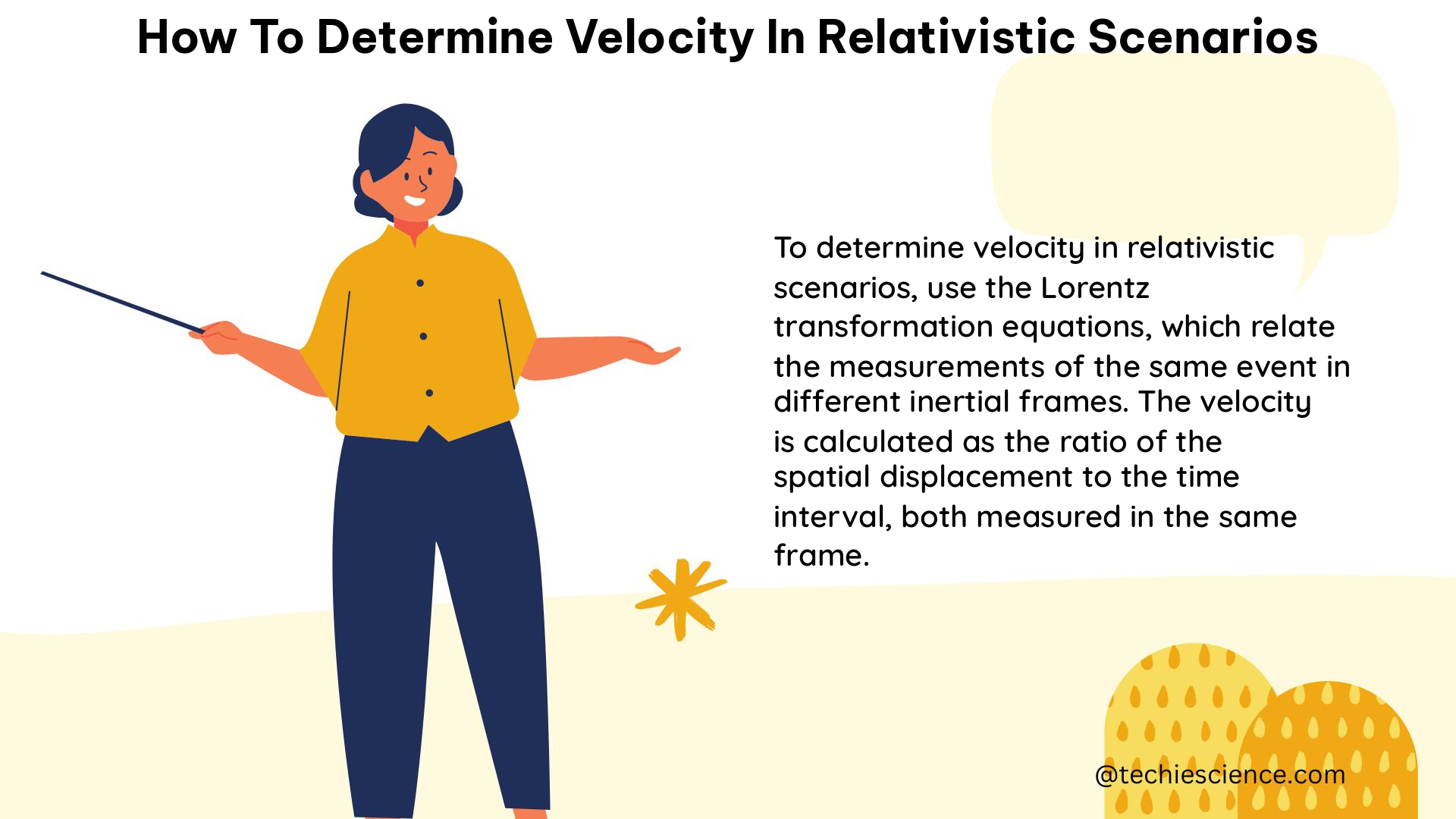In the realm of relativistic physics, understanding how to determine the velocity of objects is a crucial skill. This comprehensive guide will delve into the technical details and provide a step-by-step approach to calculating velocities in various relativistic scenarios.
The Relativistic Velocity Addition Formula
The foundation for determining velocity in relativistic scenarios is the relativistic velocity addition formula, which is given by:
s = (u + v) / (1 + (vu/c^2))
Where:
– s is the velocity of an object as observed from a certain reference frame
– u is the velocity of the object in its own rest frame
– v is the velocity of the observer’s reference frame relative to the object’s rest frame
– c is the speed of light
This formula takes into account the relative motion between the observer and the object, ensuring that the speed of light remains constant in all inertial reference frames, as per the principles of special relativity.
Applying the Formula: Example Scenarios

Let’s explore a few example scenarios to demonstrate the application of the relativistic velocity addition formula.
Example 1: Spaceship and Canister
Suppose a spaceship is approaching Earth at half the speed of light (v = 0.5c), and it shoots a canister at a speed of 0.75c relative to the spaceship (u'). To find the velocity of the canister as observed from Earth (s), we can use the formula:
s = (u + v) / (1 + (vu/c^2))
Where:
– u = 0.75c (the velocity of the canister in its own rest frame)
– v = 0.5c (the velocity of the spaceship relative to Earth)
Plugging in these values, we get:
s = (0.75c + 0.5c) / (1 + (0.5c * 0.75c / c^2))
s = 0.958c
This means that the canister is observed to be moving at a speed of 0.958c relative to Earth.
Example 2: Laser Beam from a Spaceship
Suppose a spaceship is approaching Earth at a velocity of 0.6c, and it fires a laser beam straight ahead at a velocity of 0.9c relative to the spaceship. What is the velocity of the laser beam as observed from Earth?
To solve this problem, we can use the relativistic velocity addition formula:
s = (u + v) / (1 + (vu/c^2))
Where:
– s is the velocity of the laser beam as observed from Earth
– u is the velocity of the laser beam in the rest frame of the spaceship (0.9c)
– v is the velocity of the spaceship relative to Earth (0.6c)
Plugging in these values, we get:
s = (0.9c + 0.6c) / (1 + (0.6c * 0.9c / c^2))
s = 0.945c
This means that the laser beam is observed to be moving at a velocity of 0.945c relative to Earth.
Limitations and Considerations
It is important to note that the relativistic velocity addition formula has certain limitations and considerations:
-
Speed of Light Limit: Velocities cannot add to greater than the speed of light, provided that
vis less thancandu'does not exceedc. This is because the Lorentz transformation, which is the basis for the relativistic velocity addition formula, ensures that the speed of light is the same in all inertial reference frames. -
Time Dilation and Length Contraction: The relativistic velocity addition formula takes into account the effects of time dilation and length contraction, which can reduce the observed velocity of an object compared to the sum of the velocities in their respective rest frames.
-
Inertial Reference Frames: The formula is only applicable for inertial reference frames, which are reference frames that are not accelerating. In the case of accelerating reference frames, the formula needs to be modified to account for the effects of acceleration.
-
Coordinate Transformations: In more complex scenarios, the use of coordinate transformations may be necessary to properly apply the relativistic velocity addition formula and determine the velocity of an object in a specific reference frame.
Conclusion
Determining velocity in relativistic scenarios is a crucial skill in the field of physics. By understanding the relativistic velocity addition formula and its applications, you can accurately calculate the velocity of objects as observed from different reference frames, taking into account the effects of time dilation and length contraction. This knowledge is essential for understanding and analyzing various phenomena in the realm of special relativity.
Reference:
- Relativistic Velocity Transformation – Physics LibreTexts: https://phys.libretexts.org/Bookshelves/University_Physics/University_Physics_%28OpenStax%29/University_Physics_III_-_Optics_and_Modern_Physics_%28OpenStax%29/05%3A__Relativity/5.07:_Relativistic_Velocity_Transformation
- Velocity measurement in relativistic perspectives – Physics Stack Exchange: https://physics.stackexchange.com/questions/105415/velocity-measurement-in-relativistic-perspectives
- Relativistic Energy – Physics – Lumen Learning: https://courses.lumenlearning.com/suny-physics/chapter/28-6-relativistic-energy/

The lambdageeks.com Core SME Team is a group of experienced subject matter experts from diverse scientific and technical fields including Physics, Chemistry, Technology,Electronics & Electrical Engineering, Automotive, Mechanical Engineering. Our team collaborates to create high-quality, well-researched articles on a wide range of science and technology topics for the lambdageeks.com website.
All Our Senior SME are having more than 7 Years of experience in the respective fields . They are either Working Industry Professionals or assocaited With different Universities. Refer Our Authors Page to get to know About our Core SMEs.